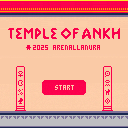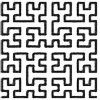Temple of Ankh
Temple of Ankh is a Rubik’s Cube-inspired game featuring an Ancient Egyptian aesthetic. It consists of a 4x4 grid with 16 unique hieroglyphs. The goal is to rearrange the grid to match the final pattern.
P.S: It’s a challenging game, so have fun and good luck! Don’t forget to share your time and move count.
How to Play
Mouse controls are enabled. Left-click to interact with buttons.
Credits
Design/Art/Music/Code: ArenaLlanura
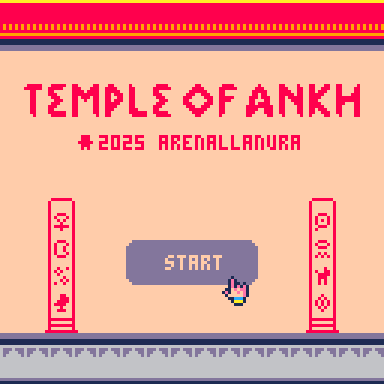
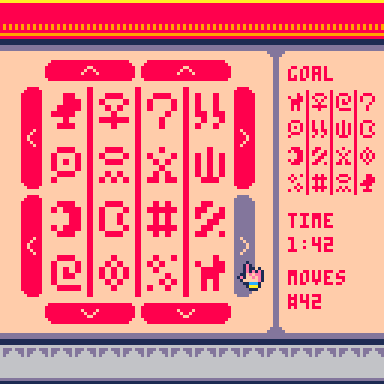
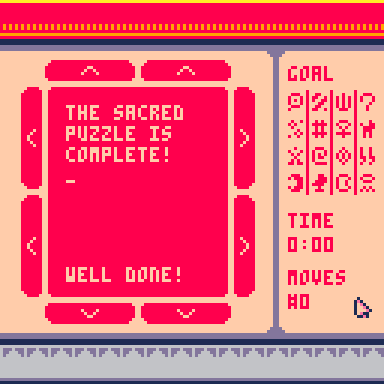

A few suggestions:
- the description should give a few pointers on what's the general suggested strategy;
- option in the custom menu: "Music off" / "on";
- alternate controls: udlr+OX buttons.

Gave myself an hour to try and solve it... I failed.
1st, I tried to deal with is like a sliding puzzle, moving tiles to their destination one by one while moving on unsolved territory. Top left 2 x 2 was no problem, and the same for R1C3, then I couldn't go further that way.
Double moves allow to swap two 2 x 2 corners. By shifting the grid before swapping, then undoing the shift, you can swap any two non overlapping 2 x 2 of the grid.
With two swaps, I placed a 6th tile, then was stuck again. (total time ~10 minutes).
After that, I switched to paper.
Clockwise from top left, I named the buttons, D- B- C A B D A- C- and started to search for algorithms, rubik's cube style.
D-B- C####C -####C A####A -####A DDBB |
F : A B A- B-
does a circular permutation of length 7.
G : F D F- D- G : A B A- B- D B A B- A- D- |
does a vertical swap of two adjacent tiles and a horizontal swap of two adjacent vertical tiles.
I thought that that would be enough to solve the puzzle and started a new game.
Timer ~30mn at start of new game.
Used G to place every tile at it's correct height, ignoring the horizontal swaps that do not change the height of tiles.
After 14 minutes, every tile was at the correct height.
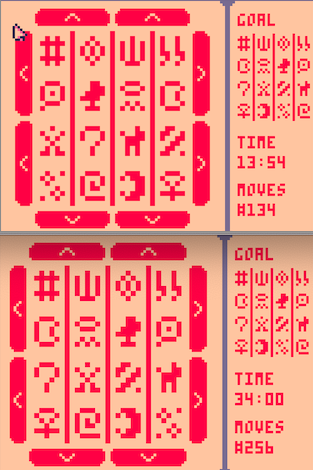
Focused then on horizontal swaps, making sure to swap the same tiles multiple times to cancel the vertical swaps.
For the bottom of the grid, things were a bit hard to keep track off because there was the global grid shift to place the horizontal tiles to swap on the right spot, the moving of the vertical segment to swap on the right spot, then the algorithm , then the vertical segment unmoving, then the grid unshifting...
I managed by taking my time, and had thee tiles left to place at the 34 minutes mark.
I needed just two more horizontal swaps with two vertical swaps on the same domino for so they would cancel, but I lost track during some grid unshifting and ended up messing up everything...
I'll retry another time, and maybe prepare more algorithms beforehand so I can move faster and not keep track of too many things to undo at once.
About the game interface itself, I found it hard to keep track of what went where. I'd probably have been much more at ease with an image, like it's done for sliding puzzles, or even better, if the tiles had been the PICO-8 palette to be put in the correct order. (I might mod the game to play like that).
The puzzle itself is great, I wonder if a physical torus version could be built...

@RealShadowCaster Thank you very much for playing and for the detailed feedback. Instead of using hieroglyphs, numbers or colors might have worked better, as you suggested but it was a bit of a stylistic choice. A physical torus version would be super cool, by the way.


A physical torus is pretty tricky to make :
imagine the lines are delimiting the 16 tiles.
Toroidal rotation (around the torus) could work, but poloidal movements wouldn't work because the inner pieces are smaller than the outer ones.
If instead of a moving structure, we carve ways from tile center to adjacent tile center and put colored marbles inside the semi closed roads, we get the opposite problem : distance between centers in poloidal dicections is fixed, but distances in toroidal direction is not.
So instead of touching marbles, we could have colored pegs protruding from the roads, and use gearing inside the torus to compensate for the distance differences and also enforce the rotation rules.
This wold look pretty cool with a transparent torus, but the resulting puzzle would he very delocate to build, hard to turn, and very susceptible to wear and tear...
What might work better is to go back to full rotating puzzle :
The puzzle would be a square donut : each piece would be a quarter of cylinder, and the four corners would be four black pieces used bot as a junctions and to transfer poloidal rotations to adjacent pieces.
So a 32 pieces assembly in total
[Please log in to post a comment]







